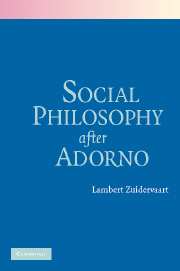Book contents
- Frontmatter
- Contents
- Preface
- Abbreviations
- Introduction: Thinking Otherwise
- 1 Transgression or Transformation
- 2 Metaphysics after Auschwitz
- 3 Heidegger and Adorno in Reverse
- 4 Globalizing Dialectic of Enlightenment
- 5 Autonomy Reconfigured
- 6 Ethical Turns
- Appendix: Adorno's Social Philosophy
- Bibliography
- Index
Introduction: Thinking Otherwise
Published online by Cambridge University Press: 18 December 2009
- Frontmatter
- Contents
- Preface
- Abbreviations
- Introduction: Thinking Otherwise
- 1 Transgression or Transformation
- 2 Metaphysics after Auschwitz
- 3 Heidegger and Adorno in Reverse
- 4 Globalizing Dialectic of Enlightenment
- 5 Autonomy Reconfigured
- 6 Ethical Turns
- Appendix: Adorno's Social Philosophy
- Bibliography
- Index
Summary
The only philosophy which can be responsibly practised in face of despair [would be] the attempt to contemplate all things as they would present themselves from the standpoint of redemption.
Adorno, Minima MoraliaI remember well the month when I began to read Theodor W. Adorno's Ästhetische Theorie. It was May 1977, during a lovely spring in Toronto. Joyce and I were house-sitting for a professor of political philosophy. In the quiet of someone else's study, surrounded by books that were not my own, I began to read Adorno's impenetrable, compelling, evocative German prose. Some days I made little headway. Other days I found myself swept along by the drama of the text, yet unable to tell anyone else where I had been or what I had learned. Gradually, however, I began to glimpse the submerged dialectical structures that sustain Adorno's thought.
My reading notes from 1977 show that I experienced Ästhetische Theorie as an array of potentially interconnected fragments held together by a provocative social vision. Although I had little understanding then of Adorno's emphasis on parataxis and constellations, I read bits and pieces, relying on intuitions about their relevance for my own concerns: first several pages on modern art (AT 33–45/ 56–74), next the chapter on truth content (AT 118–36/179–205), then some pages on progress (AT 190–9/284–96) and on society (AT 225–35/334–48, 256–61/380–7), and finally a few pages fromthe “Paralipomena” (AT 282–5/419–24).
- Type
- Chapter
- Information
- Social Philosophy after Adorno , pp. 1 - 15Publisher: Cambridge University PressPrint publication year: 2007



